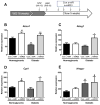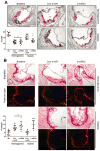miR33 inhibition overcomes deleterious effects of diabetes mellitus on atherosclerosis plaque regression in mice
- PMID: 25201910
- PMCID: PMC4194153
- DOI: 10.1161/CIRCRESAHA.115.304164
miR33 inhibition overcomes deleterious effects of diabetes mellitus on atherosclerosis plaque regression in mice
Abstract
Rationale: Diabetes mellitus increases cardiovascular disease risk in humans and remains elevated despite cholesterol-lowering therapy with statins. Consistent with this, in mouse models, diabetes mellitus impairs atherosclerosis plaque regression after aggressive cholesterol lowering. MicroRNA 33 (miR33) is a key negative regulator of the reverse cholesterol transport factors, ATP-binding cassette transporter A1 and high-density lipoprotein, which suggested that its inhibition may overcome this impairment.
Objective: To assess the effects of miR33 inhibition on atherosclerosis regression in diabetic mice.
Methods and results: Reversa mice, which are deficient in the low-density lipoprotein receptor and in which hypercholesterolemia is reversed by conditional inactivation of the microsomal triglyceride transfer protein gene, were placed on an atherogenic diet for 16 weeks, then either made diabetic by streptozotocin injection or kept normoglycemic. Lipid-lowering was induced by microsomal triglyceride transfer protein gene inactivation, and mice were treated with anti-miR33 or control oligonucleotides. Although regression was impaired in diabetic mice treated with control oligonucleotides, anti-miR33 treatment decreased plaque macrophage content and inflammatory gene expression in these mice. The decreased macrophage content in anti-miR33 treated diabetic mice was associated with a blunting of hyperglycemia-induced monocytosis and reduced monocyte recruitment to the plaque, which was traced to an inhibition of the proliferation of bone marrow monocyte precursors associated with the upregulation of their Abca1.
Conclusions: miR33 inhibition overcomes deleterious effects of diabetes mellitus in atherosclerosis regression in mice, which suggests a therapeutic strategy in diabetic patients, who remain at elevated cardiovascular disease risk, despite plasma cholesterol lowering.
Keywords: atherosclerosis; diabetes mellitus; high-density lipoprotein; microRNA; regression.
© 2014 American Heart Association, Inc.
Figures






References
-
- Beckman JA, Creager MA, Libby P. Diabetes and atherosclerosis: epidemiology, pathophysiology, and management. JAMA. 2002 May 15;287:2570–2581. - PubMed
-
- Sacks FM. After the Fenofibrate Intervention and Event Lowering in Diabetes (FIELD) study: implications for fenofibrate. Am J Cardiol. 2008 Dec 22;102:34L–40L. - PubMed
-
- Nagareddy PR, Murphy AJ, Stirzaker RA, Hu Y, Yu S, Miller RG, Ramkhelawon B, Distel E, Westerterp M, Huang LS, Schmidt AM, Orchard TJ, Fisher EA, Tall AR, Goldberg IJ. Hyperglycemia promotes myelopoiesis and impairs the resolution of atherosclerosis. Cell Metab. 2013 May 7;17:695–708. - PMC - PubMed
Publication types
MeSH terms
Substances
Grants and funding
LinkOut - more resources
Full Text Sources
Other Literature Sources
Medical
Molecular Biology Databases

